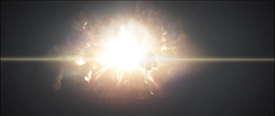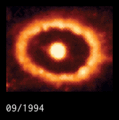Supernova: Difference between revisions
From Halopedia, the Halo wiki
(adding halowars) |
m (Link cleanup, replaced: The Etran Harborage → Trove, Battle of the Etran Harborage → Battle of Trove) |
||
| (49 intermediate revisions by 19 users not shown) | |||
| Line 1: | Line 1: | ||
{{ | {{Status|Canon}} | ||
A ''' | {{Wikipedia}} | ||
[[File:Requiem destruction.png|thumb|275px|[[Epoloch system|Epoloch]] goes supernova after consuming Requiem.]] | |||
A '''supernova''' (plural: ''supernovae'' or ''supernovas'') is a stellar explosion. They are extremely luminous and cause a burst of [[radiation]] that may briefly outshine an entire [[Milky Way|galaxy]] before fading from view over several weeks or months. During this short interval, a supernova can radiate as much energy as the [[Sol system|Sun]] could emit over its life span. The explosion expels much or all of a star's material at a velocity of up to a tenth the speed of light, driving a shock wave into the surrounding interstellar medium. This shock wave sweeps up an expanding shell of gas and dust called a supernova remnant.<ref>[[Wikipedia:Supernova|'''Wikipedia''': ''Supernova'']]</ref> | |||
On average, supernovae occur about once every 50 years in a galaxy the size of the Milky Way and play a significant role in enriching the interstellar medium with heavy elements. Furthermore, the expanding shock waves from supernova explosions can trigger the formation of new stars. | On average, supernovae occur about once every 50 years in a galaxy the size of the [[Milky Way]] and play a significant role in enriching the interstellar medium with heavy elements. Furthermore, the expanding shock waves from supernova explosions can trigger the formation of new stars. | ||
==History== | |||
In early [[Forerunner]] history, the Forerunners attempted to manipulate several stars in their [[Orion complex|region of space]]. They subsequently failed and caused several stars to supernova, leaving their [[Ghibalb|homeworld]] heavily irradiated and uninhabitable.<ref>'''[[Halo: Cryptum]]''', ''page 222''</ref> | |||
Before their defeat at the hands of the [[Flood]], and the firing of the [[Halo Array]], the Forerunner fleet had "the capacity to force premature stellar collapse," creating an artificial supernova, used to destroy entire star systems taken by the Flood.<ref>'''[[Halo 3]]''', ''[[Terminal (Halo 3)|Terminal 2]]''</ref> | |||
the | |||
According to the [[San'Shyuum]], a supernova destroyed the species' homeworld, [[Janjur Qom]], in [[648 BCE]].<ref>'''[[Halo Encyclopedia (2009 edition)]]''', ''page 113''</ref> However, many members of the [[Covenant]] doubted this claim.<ref>[https://www.halowaypoint.com/en-us/universe/locations/janjur-qom '''Halo Waypoint''': ''Janjur Qom'']</ref> | |||
During the [[Battle of Trove]] in [[2531]], Professor [[Ellen Anders]] came up with a plan to destroy the [[shield world]] and its fleet of [[Forerunner]] {{Class|Sojourner|dreadnought}}s by taking the FTL reactor of the {{UNSCShip|Spirit of Fire}} and detonating it inside the installation's internal star. This would cause the star to go supernova and obliterate the shield world.<ref>'''[[Halo Wars]]''', campaign level ''[[Reactor (Halo Wars level)|Reactor]]''</ref> Due to damage sustained during an attack by Covenant forces, Sergeant [[John Forge]] was forced to take the reactor into the star and detonate it manually. As the ''Spirit of Fire'' escaped the shield world, the internal star went supernova, destroying the planet and the Forerunner fleet, thwarting the Covenant plan.<ref>'''[[Halo Wars]]''', campaign level ''[[Escape (Halo Wars level)|Escape]]''</ref><ref>'''[[Halo Wars]]''', cutscene [http://www.youtube.com/watch?v=Rw449I95UHY&feature=player_embedded "One Less Sun in The Universe"]</ref> A debris field persisted until [[2557]] when a massive UNSC fleet destroyed the debris with a massive bombardment of [[nuclear weapon]]s.<ref>'''[[Halo: Renegades]]'''</ref> | |||
In [[2552]], Spartan [[John-117]] destroyed Halo [[Installation 04]] by detonating the fusion reactors of the crashed {{UNSCShip|Pillar of Autumn}}.<ref>'''[[Halo: Combat Evolved]]''', campaign level ''[[The Maw]]''</ref> The explosion created supernova-like temperatures and created a new element on the [[Alpha Shard]], a fragment of the installation that was propelled through [[slipspace]] to orbit a red giant. This new element was fatal to humans and was turned into a [[bioweapon]] by [[terrorist]]s. After the source of the new element was traced to Alpha Shard following the [[terrorist attack on Sedra City]], Private [[Talitha Macer]] correctly surmised that the supernova effects of the destruction of Installation 04 created it, confirmed by the lack of the element anywhere else in the known universe. [[Mission to Alpha Shard|A joint mission]] by an [[ONI]]-[[Sedran Colonial Guard]] team destroyed the deposits of this new element with a [[HAVOK tactical nuclear weapon]].<ref>'''[[Halo: Nightfall]]'''</ref> | |||
At the close of the [[Requiem Campaign]] in [[2558]], the leader of [[Jul 'Mdama's Covenant|a Covenant remnant]], [[Jul 'Mdama]], put the shield world [[Requiem]] on a collision course with the system's sun, [[Epoloch]]. When the shield world was absorbed by the sun, the star went into a supernova state and exploded, nearly destroying the {{UNSCShip|Infinity}} which narrowly escaped the shockwave into slipspace.<ref>'''[[Spartan Ops]]''', [[S1/Exodus|S1E10 ''Exodus'']]</ref> | |||
==Trivia== | |||
*The destruction of two [[Forerunner]] [[shield world]]s involved a supernova. [[Trove]] was destroyed when the {{UNSCShip|Spirit of Fire}}'s FTL reactor was used to cause the internal sun to go supernova while the destruction of [[Requiem]] in its sun [[Epoloch system|Epoloch]] caused Epoloch to go supernova. | |||
==List of appearances== | |||
*''[[Halo 3]]'' | |||
**''[[Terminal (Halo 3)|Terminals]]'' {{Fm}} | |||
*''[[Halo Wars]]'' {{1st}} | |||
*''[[Halo: Cryptum]]'' {{Mo}} | |||
*''[[Halo 4]]'' | |||
**''[[Spartan Ops]]'' | |||
*''[[Halo: Silentium]]'' {{Mo}} | |||
*''[[Halo: Escalation]]'' | |||
*''[[Halo: Nightfall]]'' {{Mo}} | |||
*''[[Halo: Smoke and Shadow]]'' {{Mo}} | |||
*''[[Halo: Renegades]]'' {{c|Referenced only}} | |||
==Gallery== | |||
<gallery> | |||
File:SN1987a debris evolution animation.gif|Animation of Supernova 1987a, showing the apex of the explosion, subsequent dissipation of the stellar remnant and buildup of ejecta within the debris ring. Note that this entire sequence takes place over a 15-year period. | |||
</gallery> | |||
==Sources== | ==Sources== | ||
{{Ref/Sources}} | |||
[[Category:Astronomy]] | [[Category:Astronomy]] | ||
[[Category:Physics]] | [[Category:Physics]] | ||
Latest revision as of 13:32, May 29, 2022
| There is more information available on this subject at Supernova on the English Wikipedia. |

A supernova (plural: supernovae or supernovas) is a stellar explosion. They are extremely luminous and cause a burst of radiation that may briefly outshine an entire galaxy before fading from view over several weeks or months. During this short interval, a supernova can radiate as much energy as the Sun could emit over its life span. The explosion expels much or all of a star's material at a velocity of up to a tenth the speed of light, driving a shock wave into the surrounding interstellar medium. This shock wave sweeps up an expanding shell of gas and dust called a supernova remnant.[1]
On average, supernovae occur about once every 50 years in a galaxy the size of the Milky Way and play a significant role in enriching the interstellar medium with heavy elements. Furthermore, the expanding shock waves from supernova explosions can trigger the formation of new stars.
History[edit]
In early Forerunner history, the Forerunners attempted to manipulate several stars in their region of space. They subsequently failed and caused several stars to supernova, leaving their homeworld heavily irradiated and uninhabitable.[2]
Before their defeat at the hands of the Flood, and the firing of the Halo Array, the Forerunner fleet had "the capacity to force premature stellar collapse," creating an artificial supernova, used to destroy entire star systems taken by the Flood.[3]
According to the San'Shyuum, a supernova destroyed the species' homeworld, Janjur Qom, in 648 BCE.[4] However, many members of the Covenant doubted this claim.[5]
During the Battle of Trove in 2531, Professor Ellen Anders came up with a plan to destroy the shield world and its fleet of Forerunner Sojourner-class dreadnoughts by taking the FTL reactor of the UNSC Spirit of Fire and detonating it inside the installation's internal star. This would cause the star to go supernova and obliterate the shield world.[6] Due to damage sustained during an attack by Covenant forces, Sergeant John Forge was forced to take the reactor into the star and detonate it manually. As the Spirit of Fire escaped the shield world, the internal star went supernova, destroying the planet and the Forerunner fleet, thwarting the Covenant plan.[7][8] A debris field persisted until 2557 when a massive UNSC fleet destroyed the debris with a massive bombardment of nuclear weapons.[9]
In 2552, Spartan John-117 destroyed Halo Installation 04 by detonating the fusion reactors of the crashed UNSC Pillar of Autumn.[10] The explosion created supernova-like temperatures and created a new element on the Alpha Shard, a fragment of the installation that was propelled through slipspace to orbit a red giant. This new element was fatal to humans and was turned into a bioweapon by terrorists. After the source of the new element was traced to Alpha Shard following the terrorist attack on Sedra City, Private Talitha Macer correctly surmised that the supernova effects of the destruction of Installation 04 created it, confirmed by the lack of the element anywhere else in the known universe. A joint mission by an ONI-Sedran Colonial Guard team destroyed the deposits of this new element with a HAVOK tactical nuclear weapon.[11]
At the close of the Requiem Campaign in 2558, the leader of a Covenant remnant, Jul 'Mdama, put the shield world Requiem on a collision course with the system's sun, Epoloch. When the shield world was absorbed by the sun, the star went into a supernova state and exploded, nearly destroying the UNSC Infinity which narrowly escaped the shockwave into slipspace.[12]
Trivia[edit]
- The destruction of two Forerunner shield worlds involved a supernova. Trove was destroyed when the UNSC Spirit of Fire's FTL reactor was used to cause the internal sun to go supernova while the destruction of Requiem in its sun Epoloch caused Epoloch to go supernova.
List of appearances[edit]
- Halo 3
- Terminals (First mentioned)
- Halo Wars (First appearance)
- Halo: Cryptum (Mentioned only)
- Halo 4
- Halo: Silentium (Mentioned only)
- Halo: Escalation
- Halo: Nightfall (Mentioned only)
- Halo: Smoke and Shadow (Mentioned only)
- Halo: Renegades (Referenced only)
Gallery[edit]
Sources[edit]
- ^ Wikipedia: Supernova
- ^ Halo: Cryptum, page 222
- ^ Halo 3, Terminal 2
- ^ Halo Encyclopedia (2009 edition), page 113
- ^ Halo Waypoint: Janjur Qom
- ^ Halo Wars, campaign level Reactor
- ^ Halo Wars, campaign level Escape
- ^ Halo Wars, cutscene "One Less Sun in The Universe"
- ^ Halo: Renegades
- ^ Halo: Combat Evolved, campaign level The Maw
- ^ Halo: Nightfall
- ^ Spartan Ops, S1E10 Exodus
